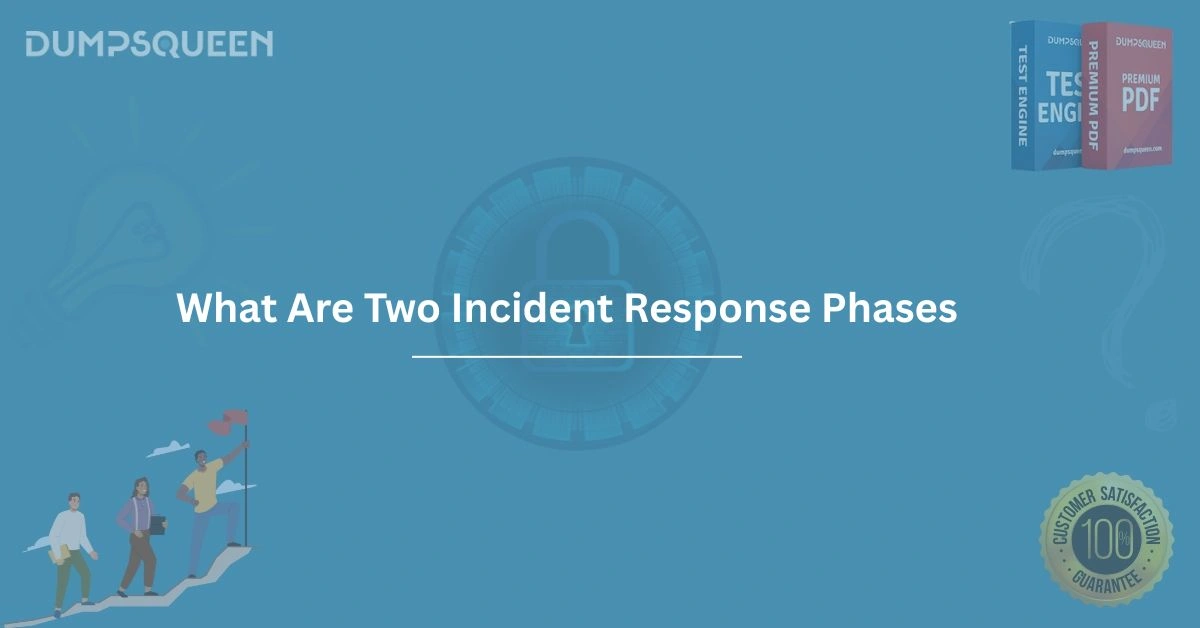Introduction
In today’s interconnected digital landscape, cyber incidents are an unfortunate reality for organizations of all sizes. From data breaches to ransomware attacks, the ability to respond swiftly and effectively to security incidents is critical for minimizing damage, ensuring business continuity, and maintaining trust with stakeholders. Incident response is a structured approach to identifying, managing, and mitigating cyber threats, and it is built upon several well-defined phases.
Among these, two critical phases—Preparation and Identification—lay the foundation for a robust incident response strategy. This comprehensive guide, brought to you by DumpsQueen, explores these two phases in detail, offering insights into their importance, processes, and best practices. Whether you’re an IT professional, a cybersecurity enthusiast, or a business leader, understanding these phases is essential for safeguarding your organization. Visit the official DumpsQueen website for more resources to enhance your cybersecurity knowledge and skills.
The Importance of Incident Response in Cybersecurity
Incident response is not just a reactive process; it is a proactive discipline that enables organizations to anticipate, detect, and recover from security incidents. A well-executed incident response plan reduces downtime, limits financial losses, and protects an organization’s reputation. According to industry reports, organizations with a formal incident response plan can reduce the cost of a data breach by up to 30%. The preparation and identification phases are the cornerstones of this process, ensuring that organizations are ready to act when an incident occurs and can quickly pinpoint the nature and scope of the threat. DumpsQueen emphasizes the importance of mastering these phases to build a resilient cybersecurity posture.
Preparation: The Foundation of Effective Incident Response
The preparation phase is the bedrock of any successful incident response strategy. It involves proactive measures to ensure that an organization is ready to handle a security incident before it occurs. This phase is not about reacting to an active threat but about building the capabilities, processes, and mindset needed to respond effectively when the time comes.
Building an Incident Response Plan
A comprehensive incident response plan is the centerpiece of the preparation phase. This document outlines the policies, procedures, and resources required to manage a security incident. It should include clear roles and responsibilities for the incident response team, communication protocols, and escalation procedures. For example, the plan should specify who is responsible for notifying stakeholders, such as customers, regulators, or law enforcement, in the event of a breach. DumpsQueen recommends that organizations regularly update their incident response plans to reflect changes in their IT environment, threat landscape, or regulatory requirements.
Assembling an Incident Response Team
The success of the preparation phase depends on the strength of the incident response team. This team typically includes IT professionals, cybersecurity experts, legal advisors, and communication specialists. Each member should have clearly defined roles, such as incident coordinator, forensic analyst, or public relations liaison. Training is a critical component of team preparation. DumpsQueen offers a range of cybersecurity training materials on its official website, including resources for incident response certifications like CompTIA Security+ and CISSP, which can equip team members with the skills needed to excel in their roles.
Conducting Risk Assessments and Threat Modeling
Preparation also involves understanding the organization’s vulnerabilities and potential threats. A thorough risk assessment identifies critical assets, such as customer data, intellectual property, or operational systems, and evaluates the likelihood and impact of various threats. Threat modeling takes this a step further by simulating potential attack scenarios, such as phishing campaigns or insider threats, to identify weaknesses in the organization’s defenses. By conducting these exercises, organizations can prioritize their security investments and tailor their incident response plans to address the most likely threats.
Implementing Security Controls and Tools
To prepare for incidents, organizations must deploy robust security controls and monitoring tools. Firewalls, intrusion detection systems (IDS), and endpoint protection solutions are essential for preventing and detecting threats. Security information and event management (SIEM) systems play a crucial role in aggregating and analyzing log data to identify suspicious activity. DumpsQueen advises organizations to regularly test and update these tools to ensure they are effective against evolving threats. Additionally, maintaining secure backups of critical data is a key preparation step, as it enables organizations to restore systems quickly in the event of a ransomware attack or data loss.
Training and Awareness Programs
Human error is a leading cause of security incidents, making employee training a vital part of the preparation phase. Regular cybersecurity awareness programs can educate staff about common threats, such as phishing emails or social engineering attacks, and teach them how to recognize and report suspicious activity. Simulated phishing exercises, for example, can help employees practice identifying malicious emails in a safe environment. DumpsQueen’s official website offers training resources to help organizations build a culture of cybersecurity awareness among their workforce.
Testing and Refining the Plan
An incident response plan is only as good as its execution. Regular testing through tabletop exercises or full-scale simulations allows organizations to evaluate the effectiveness of their plan and identify areas for improvement. These exercises should involve all members of the incident response team and simulate realistic scenarios, such as a data breach or a distributed denial-of-service (DDoS) attack. After each exercise, the team should conduct a debrief to document lessons learned and update the plan accordingly. DumpsQueen emphasizes that continuous improvement is key to maintaining a robust incident response capability.
Identification: Detecting and Assessing Security Incidents
Once an organization is prepared, the next critical phase is identification. This phase focuses on detecting potential security incidents, determining whether an incident has occurred, and assessing its scope and impact. Rapid and accurate identification is essential for containing a threat before it escalates.
Monitoring and Detection
The identification phase begins with continuous monitoring of the organization’s IT environment. SIEM systems, IDS, and other monitoring tools play a central role in this process by analyzing network traffic, system logs, and user activity for signs of suspicious behavior. For example, a SIEM system might flag an unusual number of failed login attempts, indicating a possible brute-force attack. DumpsQueen recommends configuring these tools to generate real-time alerts, enabling the incident response team to investigate potential incidents promptly.
Recognizing Indicators of Compromise (IOCs)
Indicators of compromise (IOCs) are clues that suggest a security incident may have occurred. These can include unusual network traffic, unauthorized changes to system files, or the presence of malicious code. The identification phase involves training the incident response team to recognize these indicators and distinguish between benign anomalies and genuine threats. For instance, a spike in outbound traffic might be caused by a legitimate software update or a data exfiltration attempt. DumpsQueen’s cybersecurity training resources, available on its official website, provide in-depth guidance on identifying and analyzing IOCs.
Incident Triage and Classification
Once a potential incident is detected, the incident response team must triage and classify it to determine its severity and priority. This involves gathering initial information about the incident, such as the affected systems, the type of threat, and the potential impact. For example, a malware infection on a single workstation may be a low-priority incident, while a breach of a customer database is a high-priority issue. The team should use a predefined classification framework, such as NIST’s incident severity levels, to guide this process. Accurate classification ensures that resources are allocated effectively and that critical incidents are escalated to senior management or external stakeholders as needed.
Initial Investigation and Scoping
The identification phase also includes an initial investigation to determine the scope of the incident. This involves collecting and analyzing evidence, such as log files, network packets, or memory dumps, to understand the nature of the threat. For example, if a phishing email is suspected, the team might analyze the email headers to trace its origin or examine any malicious attachments. Forensic tools, such as EnCase or FTK, can assist in this process by preserving evidence and maintaining a chain of custody. DumpsQueen advises organizations to document all findings during this phase, as this information will inform subsequent response efforts.
Engaging Stakeholders
Effective communication is a critical component of the identification phase. The incident response team must notify relevant stakeholders, such as IT staff, management, or third-party vendors, about the incident. In some cases, external entities, such as law enforcement or regulatory bodies, may need to be informed, particularly if the incident involves sensitive data or critical infrastructure. The incident response plan should include clear guidelines for when and how to engage these stakeholders. DumpsQueen’s training materials provide templates and best practices for drafting incident notifications that are clear, concise, and compliant with regulatory requirements.
Best Practices for Mastering Preparation and Identification
To excel in the preparation and identification phases, organizations should adopt a proactive and systematic approach. First, invest in regular training and certifications for the incident response team. DumpsQueen’s official website offers a wealth of resources, including study guides and practice exams, to help professionals stay current with industry best practices. Second, leverage automation to enhance monitoring and detection capabilities. Automated tools can reduce the time it takes to identify and triage incidents, allowing the team to focus on high-priority tasks. Finally, foster a culture of collaboration and communication within the organization. Incident response is a team effort, and effective coordination between departments can make the difference between a swift recovery and a prolonged crisis.
The Role of DumpsQueen in Strengthening Incident Response
DumpsQueen is committed to empowering organizations and individuals with the knowledge and tools needed to excel in cybersecurity. The official DumpsQueen website offers a wide range of resources, including training courses, certification guides, and practice exams, to help professionals master incident response and other critical cybersecurity disciplines. Whether you’re preparing for a certification like CompTIA Security+, CISSP, or CEH, or simply looking to enhance your incident response skills, DumpsQueen has the resources to support your journey.
Conclusion
The preparation and identification phases are the foundation of a successful incident response strategy. By proactively building capabilities, training teams, and deploying robust monitoring tools, organizations can detect and respond to security incidents with confidence. The preparation phase ensures that the organization is ready to act, while the identification phase enables rapid detection and assessment of threats. Together, these phases minimize the impact of incidents and pave the way for effective containment, eradication, and recovery. DumpsQueen is proud to support organizations and professionals in mastering these critical phases through its comprehensive cybersecurity resources. Visit the official DumpsQueen website today to explore training materials, practice exams, and more, and take the first step toward building a resilient cybersecurity posture.
Free Sample Questions
Question 1: What is the primary goal of the preparation phase in incident response?
A) To recover systems after an incident
B) To proactively build capabilities to handle incidents
C) To contain and eradicate threats
D) To analyze the root cause of an incident
Answer: B) To proactively build capabilities to handle incidents
Question 2: Which tool is commonly used during the identification phase to detect suspicious activity?
A) Customer Relationship Management (CRM) system
B) Security Information and Event Management (SIEM) system
C) Project Management Software
D) Enterprise Resource Planning (ERP) system
Answer: B) Security Information and Event Management (SIEM) system
Question 3: What is an example of an Indicator of Compromise (IOC)?
A) A scheduled software update
B) Unauthorized changes to system files
C) Routine employee login activity
D) A planned network maintenance event
Answer: B) Unauthorized changes to system files
Question 4: Why is incident triage important during the identification phase?
A) To restore affected systems to normal operation
B) To determine the severity and priority of an incident
C) To implement long-term security improvements
D) To train employees on cybersecurity awareness
Answer: B) To determine the severity and priority of an incident



